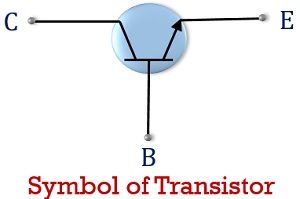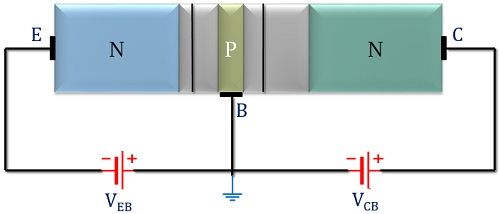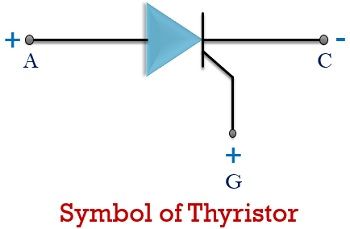Both transistor and thyristor are the types of semiconductor devices. But some factors exist that differentiates the two. The crucial difference between transistor and thyristor is that a transistor is a 3-layer device that requires regular current pulse in order to ensure conduction.
On the contrary, a thyristor is a 4-layer device that needs an only single triggering pulse to initiate and maintain conduction.
Both transistor and thyristor are 3 terminal devices. But the three terminals of the transistor are emitter, base and collector and that of thyristor are anode, cathode and gate.
In the upcoming section of this article, you will get an idea about other important differences between the two. But, before that have a look at the contents to be discussed here.
Content: Transistor Vs Thyristor
Comparison Chart
| Parameter | Transistor | Thyristor |
|---|---|---|
| Basic | It is a 3 layer device used for amplification purpose. | It is a 4 layer device used for rectification purpose. |
| Number of junction | It has 2 junctions. | It consists of 3 junctions. |
| Device triggering | To ensure proper conduction of the device regular current pulse must be provided to it. | It requires single triggering pulse at initial state in order to start and maintain conduction. |
| Power rating | Its rating is in Watts. | Its rating is in Kilowatts. |
| Cost | Low cost | It is quite expensive than transistor. |
| Size | Small in size and less bulky. | It has comparatively larger size thus is bulkier than transistor. |
| Current rating | It possesses low current rating. | Current rating is comparatively high in case of thyristor. |
| Turn-on time | It turns on faster than thyristor. | This device takes more time to turn on. |
| Commutation circuit | Not required | Required |
| Power losses | It exhibits high power loss. | The power loss is comparatively low in case of thyristor than transistor. |
| Suitability in application | Suited for high frequency applications but not for high power applications | Suited for high power applications but not for high frequency applications. |
Definition of Transistor
A transistor is a device made of semiconductor material that consists of 3 layers and 3 terminals. The word transistor is a merger of two different words that are transfer and resistor. This simply defines the operation of the transistor. It is a device that transfers the resistance from one region to another in order to ensure conduction, thereby amplifying the signal.
Basically, silicon and germanium are the semiconductor materials that are used for the fabrication of the transistor.
Here, we can see the symbolic representation of the transistor:

Transistors are majorly classified as NPN and PNP transistors. This classification totally depends on the type of material used and the associated majority charge carriers responsible for conduction.
The figure below represents the NPN transistor with biasing arrangement:

Here, we can clearly see that a transistor is a 2 pn junction device. The three terminals of the transistor are emitter, base and collector.
When proper biasing is provided to the device then the majority charge carriers flow from an end to another that resultantly causes conduction to take place.
As we have considered here an NPN transistor then the majority charge carriers responsible for the flow of current over here are electrons.
So, when a forward voltage is applied at the emitter-base junction of the transistor then electrons from the emitter region drifts across the base region after overcoming the barrier potential of that junction.
On reaching the thin base region where the majority carriers are holes, only some of the electrons get combine with the holes and rest move towards the collector region. Then the majority charge carriers get collected at the collector.
Due to this movement conduction takes place through the device and current flows from collector to emitter (opposite to the direction of flow of electrons) through the transistor.
Definition of Thyristor
A thyristor is a semiconductor device consisting of 4 layers and 3 terminals. The thyristor is the merger of the words thyratron and transistor. As it performs rectification like thyratron and controlling like a transistor.
It is basically an alternate arrangement of p and n-type semiconductor materials; this is clearly represented in the figure below:

Also, the figure below shows the symbolic representation of thyristor:

The thyristor is a device that starts conducting only when gate triggering pulse is applied across its terminal. When forward or reverse voltage is applied to the device without any gate triggering pulse then the device does not conduct.
It is necessary to apply forward gate voltage in order to start and maintain conduction through the thyristor.
The figure below represents the biasing arrangement of thyristor:

Here, a forward voltage is provided to anode wrt cathode. Also, the gate terminal is forward biased with respect to the cathode.
This causes all the three junctions to be forward biased so, majority carriers start drifting from emitter to the collector region. If the gate potential is not applied, then the intermediate junction will remain in reverse biased condition and block the flow of carriers.
Once, the applied gate potential forward biases the middle junction then it will permit continuous flow of current. Even after removal of the gate triggering pulse the device continues to conduct due to the cummulative action.
Key Differences Between Transistor and Thyristor
- A transistor can only withstand small output power hence it is rated in watts. While a thyristor exhibits better ability to manage large power than a transistor thus it is rated in Kilowatts.
- A transistor is composed of 3 layers namely npn or pnp while a thyristor is composed of 4 layers i.e., pnpn.
- When power transistors are employed in the electronic circuits then it reduces the overall cost of the system. Whereas the use of thyristor in circuits increases the cost. Thereby making it expensive.
- Transistor does not exhibits surge current capacity characteristic thus is able to handle the only small rate of change of current. As against, a thyristor exhibits surge current characteristic and hence can bear a comparatively high rate of change of current than a transistor.
- A transistor switches on fast, thus it exhibits faster turn-on time than that of the thyristor.
- Transistor circuit does not require commutation circuit. However, in the case of thyristor commutation circuit is needed.
- The internal power losses in case the transistor is high as compared to the thyristor.
- Transistors are suitable for high-frequency applications but not for high power applications. As against, thyristors are suitable for high power applications but not for high-frequency applications.
Conclusion
So, from the above discussion, we can conclude that both transistor and thyristor have their own set of benefits in their respective applications. But thyristor somewhat exhibits better reliability than that of the transistor.